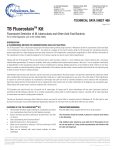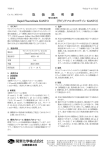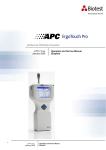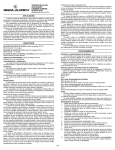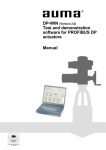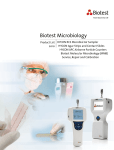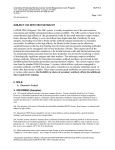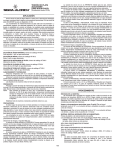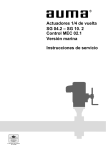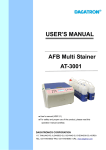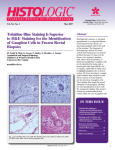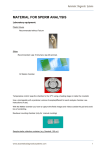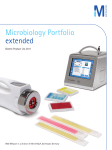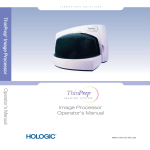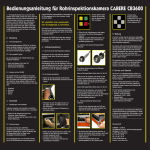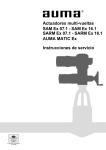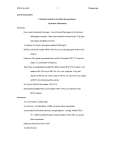Download TB Fluorostain™ Kit
Transcript
Corporate Headquarters 400 Valley Road Warrington, PA 18976 1-800-523-2575 FAX 1-800-343-3291 Email: info@ polysciences.com www.polysciences.com Europe - Germany Polysciences Europe GmbH Handelsstr. 3 D-69214 Eppelheim, Germany (49) 6221-765767 FAX (49) 6221-764620 Email: [email protected] TECHNICAL DATA SHEET 488 Page 1 of 2 TB Fluorostain™ Kit Fluorescent Detection of M. tuberculosis and Other Acid-Fast Bacteria Catalog Number 22422-1 For In Vitro Diagnostic Use in the United States Introduction A Fluorescence Method for Demonstrating Acid-Fast Bacteria The TB Fluorostain™ Kit is a fluorescent based rapid microwave staining method using Auramine O-Rhodamine B with the counterstain Eriochrome Black T. First introduced by Charles Churukian in 19911, the method is a variation of the Truant2 method. Using the TB Fluorostain Kit, mycobacteria fluoresce bright orange yellow on a black background and are easily scanned at 100X magnification. Increasing the magnification to 400X will allow confirmation of the mycobacterium strain. An objective designed for oil immersion viewing can also be used at these magnifications. Staining with the TB Fluorostain™ Kit can be performed with a rapid microwave method or a more traditional oven method. Staining with a microwave method takes approximately 10 minutes to complete, while using a traditional oven-based method requires a little over 1 hour to complete. Heat fixation or deparaffination of the mycobacteria specimen must be completed prior to staining. Multiple specimens can be stained by either method. Do not reuse stains as smears can shed during staining causing contamination of the solutions and other slides. A known positive control should be run with each group of slides to assure the stain is working properly. Ziehl-Neelsen carbol-fuchsin stain has been used for many years as an alternative to fluorescent stains. The specimens stained by this method are viewed with a standard light microscope and are stained bright red to dark pink on a light blue background. A slow scan of the entire slide at 100X magnification is required to confirm the presence of mycobacteria. Erythrocytes stain pink and must be carefully evaluated to avoid confusion with mycobacteria. Specimens stained with the TB Fluorostain Kit can be restained with carbol-fuchsin stain for further confirmation of the diagnosis and mycobacteria type. Slides stained with carbol-fuchsin cannot be restained with a fluorochrome. TB Fluorostain and carbol-fuschin are not specific for M. tuberculosis. M. leprae and M. avium-intracellulare will also stain. Specimens should be submitted to the Microbiology Laboratory for a complete mycobacteria culture profile to confirm diagnosis. However, a positive with an initial rapid stain for tuberculosis can assist in starting patient treatment. Consult your fluorescent microscope User's Manual to assure you have the correct filter for viewing Auramine O-Rhodamine B. The filter type for each fluorescent microscope may be listed differently. Magnification objectives at 10X (final 100X) and 40X (final 400X) are also needed. Features of the TB Fluorostain™ Kit Precautions/Warnings • TB Fluorostain Kit allows rapid screening for mycobacteria and stains more mycobacteria strains than the Ziehl-Neelsen procedure • Using a microwave procedure, staining can be performed in less than 10 minutes • Fast counterstaining with Eriochrome Black T • Reduced fluorescence in the background • Slides can be screened for staining at 100X and confirmed at 400X dry or under oil immersion • Slides can be restained with carbol fuchsin methods for further confirmation Read the MSDS sheets supplied with the kit for all precautions. The microwave should be vented or placed in a hood to avoid fumes in the laboratory. Only distilled water should be used with the TB Fluorostain Kit. Do not use tap water as it may contain mycobacteria and interfere with the stain and diagnosis. Should any of our materials fail to perform to our specifications, we will be pleased to provide replacements or return the purchase price. We solicit your inquiries concerning all needs for life sciences work. The information given in this bulletin is to the best of our knowledge accurate, but no warranty is expressed or implied. It is the user’s responsibility to determine the suitability for his own use of the products described herein, and since conditions of use are beyond our control, we disclaim all liability with respect to the use of any material supplied by us. Nothing contained herein shall be construed as a recommendation to use any product or to practice any process in violation of any law or any government regulation. © Polysciences, Inc. 0205 RevC Data Sheet #488 1 TECHNICAL DATA SHEET 488 Page 2 of 2 Specimen Preparation for Paraffin and Smears: Paraffin blocks should be sectioned at 4 to 6 microns and placed on slides. The slides should be dried completely and deparaffinized prior to staining by standard laboratory protocol. Smears, touch preparations of fresh tissue specimens, and body fluids should be heat treated as the fixation step. To heat fix the slides, place them on a slide warmer or hot plate at 65ºC to 75ºC for at least 2 hours. The slides should be cooled to room temperature prior to staining. Materials Required for the TB Fluorostain Kit, but not supplied: • Prepared slides at room temperature (Either deparaffinized or heat fixed smears) • Fluorescent Microscope with appropriate filter for Rhodamine • 4 Coplin jars that can hold 35 to 40ml of solution per jar OR 4 microwave-safe staining dishes with slide rack and handle for the rack* • Microwave Oven or Standard Laboratory Oven Well vented • Deionized or Distilled Water • Coverslips and Aqueous Coverslipping Media Microwave Staining Procedure: 1. Fill a plastic microwave-safe Coplin jar with 35 to 40ml of TB Fluorostain Solution A.* 2. Place the Coplin jar in the microwave with a loose cap for 15 to 30 seconds to bring the solution to 65ºC to 70ºC and remove from the microwave. 3. The slides should be added to the hot solution and agitated or dipped up and down to assure the entire section or smear is evenly coated. The solution will be stable for the 3 to 4 minutes required to complete the stain at room temperature or sitting in the microwave. It will not require further heating. Overheating may cause the Coplin jar to overflow. 4. Allow the slides to stain in the hot solution for 3 to 4 minutes. No agitation is required for this step. 5. Remove the slides to a clean Coplin jar containing distilled water to remove excess stain solution. Fill and drain the Coplin jar three times with distilled water to remove the stain solution from the slides. 6. Differentiate in 2 changes of 35 to 40ml of TB Fluorostain Solution B* in Coplin jars for 1 1/2 minutes each change. 7. Quickly rinse in 4 changes of distilled water in a Coplin jar, filling and draining to remove all excess staining solution from the slides. 8. Counterstain with TB Fluorostain Solution C* in a Coplin jar or staining dish for 8 to 10 seconds only. Longer staining may interfere with the fluorescence in the stain. 9. Quickly rinse in 3 changes of distilled water in a Coplin jar by filling and draining to remove excess stain from the slides. 10. Smear or touch preparations should be placed in a stand vertically and allowed to dry thoroughly prior to examination or coverslipped with Aqua-Poly/Mount (Catalog #18606). 11. Coverslip paraffin sections with Aqua-Poly/Mount (Catalog #18606) or other aqueous media to prevent loss of the fluorescence. * Larger volumes of stain can be used in microwave-safe staining containers as required. A staining dish with 200 to 250ml of solution will require 2 to 3 minutes in the microwave to attain temperature. The staining dishes used for non-microwave steps will also require 200-250ml of each solution or distilled water as directed for the rinse steps listed above. Traditional Staining Procedure: 1. Fill a plastic microwave-safe Coplin jar with 35 to 40ml of TB Fluorostain Solution A. 2. Place the Coplin jar in a 60º to 65ºC standard oven until it comes to temperature then follow the microwave staining procedure from step 3. The solution can be held in the oven for several days if it is vented or in a hood however, it should not be reused. Larger staining dishes can be used as needed. Results: Mycobacteria, including M. tuberculosis, M. leprae, M. avium-intracellular fluoresce orange-yellow on a dark black background. Numerous rod shaped organisms should be detected. Viable and non-viable organisms may be present and stained. M. tuberculosis appears as slightly curved or straight rods with rounded ends. The rods will be 0.3 to 0.6µm in length. Ordering Information: Cat # Description Size 22422-1 TB Fluorostain™ Kit 16864-3.75 Poly/LEM Fixative (10% NBF not stabilized for LM & EM) 08389-1 Xylene, Histology Grade 09860-1 Reagent Alcohol 18606-20 Aqua-Poly/Mount 18606-500 Aqua-Poly/Mount 24216-1 Tissue Tack Microscope Slides (Silane coated) 22247-1 Poly-L-Lysine Microscope Slides 1 Kit 3.75L 3.8L 3.8L 20mL 500mL 1 box 1 box References: 1. Journal of Histotechnology, 14(2):117-121, 1991 2. Henry Ford Hospital Medical Bulletin, 10:287-96, 1962 Should any of our materials fail to perform to our specifications, we will be pleased to provide replacements or return the purchase price. We solicit your inquiries concerning all needs for life sciences work. The information given in this bulletin is to the best of our knowledge accurate, but no warranty is expressed or implied. It is the user’s responsibility to determine the suitability for his own use of the products described herein, and since conditions of use are beyond our control, we disclaim all liability with respect to the use of any material supplied by us. Nothing contained herein shall be construed as a recommendation to use any product or to practice any process in violation of any law or any government regulation. © Polysciences, Inc. 0205 RevC Data Sheet #488 1


